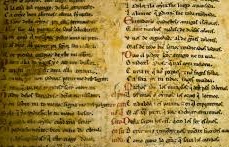The etymological root of the term incunabulum comes from the Latin word incunabŭla , which can be translated as “diapers” . The concept is used to describe those books that were published in the period between the creation of the printing press and the beginning of the 16th century .
Specifically, we can establish that aforementioned Latin word is the result of the sum of several lexical components of said language:
-The prefix “in-”, which is equivalent to “inwards”.
-The noun “cunae”, which is synonymous with “cradle”.
-The suffix “-bula”, which is used to indicate “instrument”.
 Incunabulum, therefore, is an adjective applied to works printed between approximately 1450 and 1500 . Sometimes, the temporal delimitation is simplified by indicating that the incunabula are books from the 15th century .
Incunabulum, therefore, is an adjective applied to works printed between approximately 1450 and 1500 . Sometimes, the temporal delimitation is simplified by indicating that the incunabula are books from the 15th century .
It is estimated that the idea of the incunabulum was coined in the 17th century . Bernhard von Mallinckrodt and Cornelius Beughem are often cited as the first to capture the notion in publication.
In the time of the incunabula, the printer was in charge of the entire process. He not only owned the press, but also manufactured the paper, was in charge of the type casting, and was the bookbinder, publisher, and bookseller. The relevance of the incunabula is given by being the first documents that expanded the reach of culture.
Other interesting facts about the incunabula are the following:
-It is important to know the existence of the proto-incunabula and the post-incunabula. The former are the books that were printed in the initial printing presses between 1472 and 1480, while the latter are the books that were printed at the beginning of the 16th century and that have been mistakenly classified as incunabula.
-The first printed book in Spain that is preserved is “Sinodal de Aguilafuente”, which was printed in the year 1472 by the German Juan Párix of Heidelberg.
-Incunabula usually have several characteristics in common, such as few divisions in the total text, few characters, the lack of the title on a separate page, the absence of pagination, the non-existence of indentation to separate chapters or paragraphs...
As etymology suggests, the idea of incunabulum is linked to the fact that printed books were “diapers” or in the “cradle” . In the 15th century there were around 1,200 printing presses that made it possible to publish thousands of works: all of them classified as incunabula.
The Bavarian State Library , in Germany , is one of the institutions that has the largest number of incunabula, housing more than 18,000. Among them is the Gutenberg Bible , considered the most famous incunabulum since it was the first book to be printed on a large scale using a system of movable type.
Other important incunabula, in the case of Spain, are “The Twelve Labors of Hercules” which was printed in 1483 in Zamora by Enrique de Villena or the tragicomedy “La Celestina” by Fernando Rojas, which was printed in the year 1499 in Burgos by Fadrique de Basel and which is considered one of the great classics of literature in Spanish.
